Law Assignment: Hart's Rules, Australian Legal System & Contract Law
VerifiedAdded on 2020/02/19
|13
|2929
|33
Report
AI Summary
This law assignment analyzes key legal concepts. Part A explains Hart's theory of secondary rules, including rules of recognition, change, and adjudication, and their role in enforcing primary rules, as applied to introducing rules to a tribe. Part B discusses the Australian legal system, including its federal structure, adversarial and inquisitorial features, and the roles of common law and statutory law. Part C examines the case of Commercial Bank of Australia v Amadio, focusing on unconscionable conduct in contract law. It explores factors affecting genuine consent, relevant legislation (ACL), and the bank's obligations. Part D briefly addresses contract termination due to frustration, referencing the case of Taylor v Caldwell. The assignment provides a comprehensive overview of these legal principles.

Running Head: Law 1
Law
Law
Paraphrase This Document
Need a fresh take? Get an instant paraphrase of this document with our AI Paraphraser
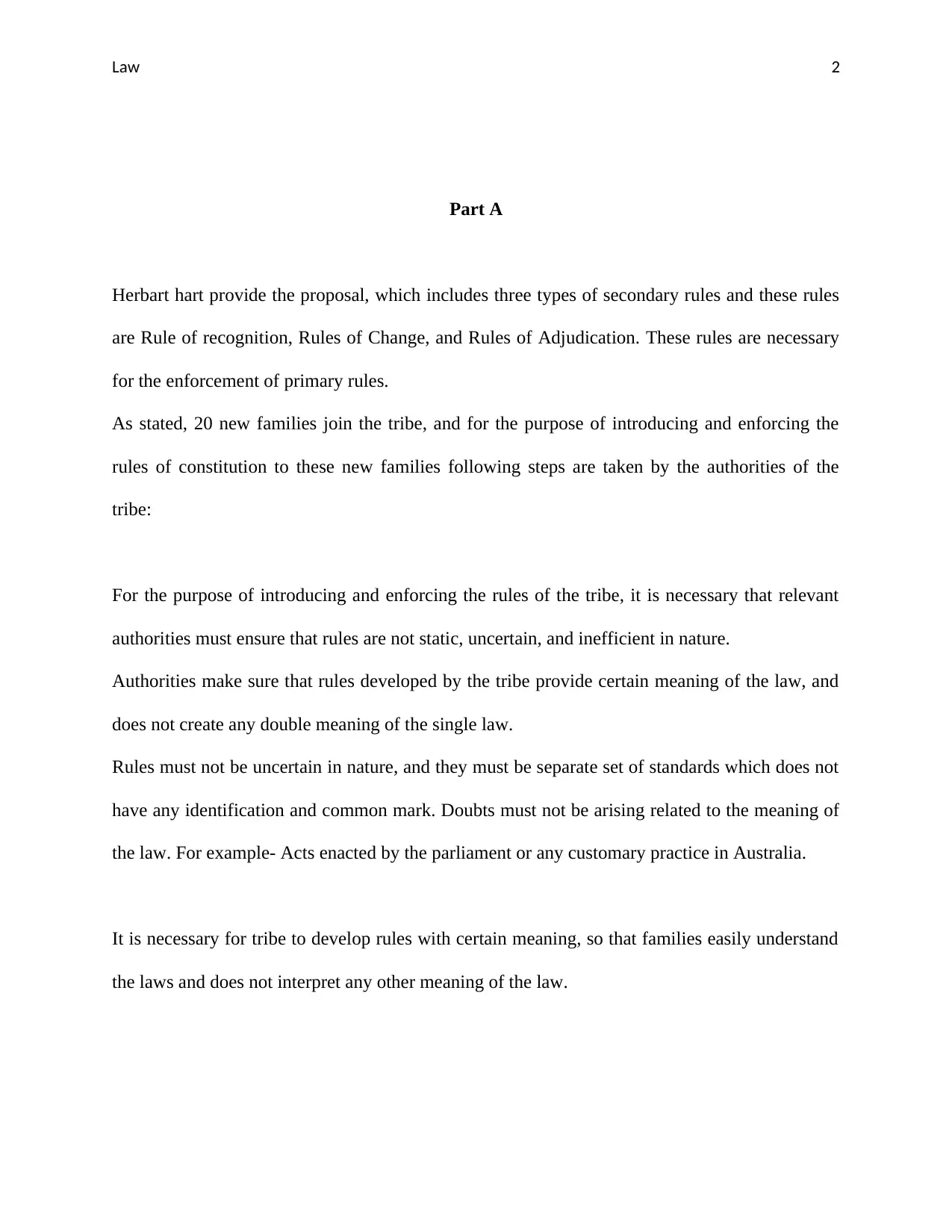
Law 2
Part A
Herbart hart provide the proposal, which includes three types of secondary rules and these rules
are Rule of recognition, Rules of Change, and Rules of Adjudication. These rules are necessary
for the enforcement of primary rules.
As stated, 20 new families join the tribe, and for the purpose of introducing and enforcing the
rules of constitution to these new families following steps are taken by the authorities of the
tribe:
For the purpose of introducing and enforcing the rules of the tribe, it is necessary that relevant
authorities must ensure that rules are not static, uncertain, and inefficient in nature.
Authorities make sure that rules developed by the tribe provide certain meaning of the law, and
does not create any double meaning of the single law.
Rules must not be uncertain in nature, and they must be separate set of standards which does not
have any identification and common mark. Doubts must not be arising related to the meaning of
the law. For example- Acts enacted by the parliament or any customary practice in Australia.
It is necessary for tribe to develop rules with certain meaning, so that families easily understand
the laws and does not interpret any other meaning of the law.
Part A
Herbart hart provide the proposal, which includes three types of secondary rules and these rules
are Rule of recognition, Rules of Change, and Rules of Adjudication. These rules are necessary
for the enforcement of primary rules.
As stated, 20 new families join the tribe, and for the purpose of introducing and enforcing the
rules of constitution to these new families following steps are taken by the authorities of the
tribe:
For the purpose of introducing and enforcing the rules of the tribe, it is necessary that relevant
authorities must ensure that rules are not static, uncertain, and inefficient in nature.
Authorities make sure that rules developed by the tribe provide certain meaning of the law, and
does not create any double meaning of the single law.
Rules must not be uncertain in nature, and they must be separate set of standards which does not
have any identification and common mark. Doubts must not be arising related to the meaning of
the law. For example- Acts enacted by the parliament or any customary practice in Australia.
It is necessary for tribe to develop rules with certain meaning, so that families easily understand
the laws and does not interpret any other meaning of the law.
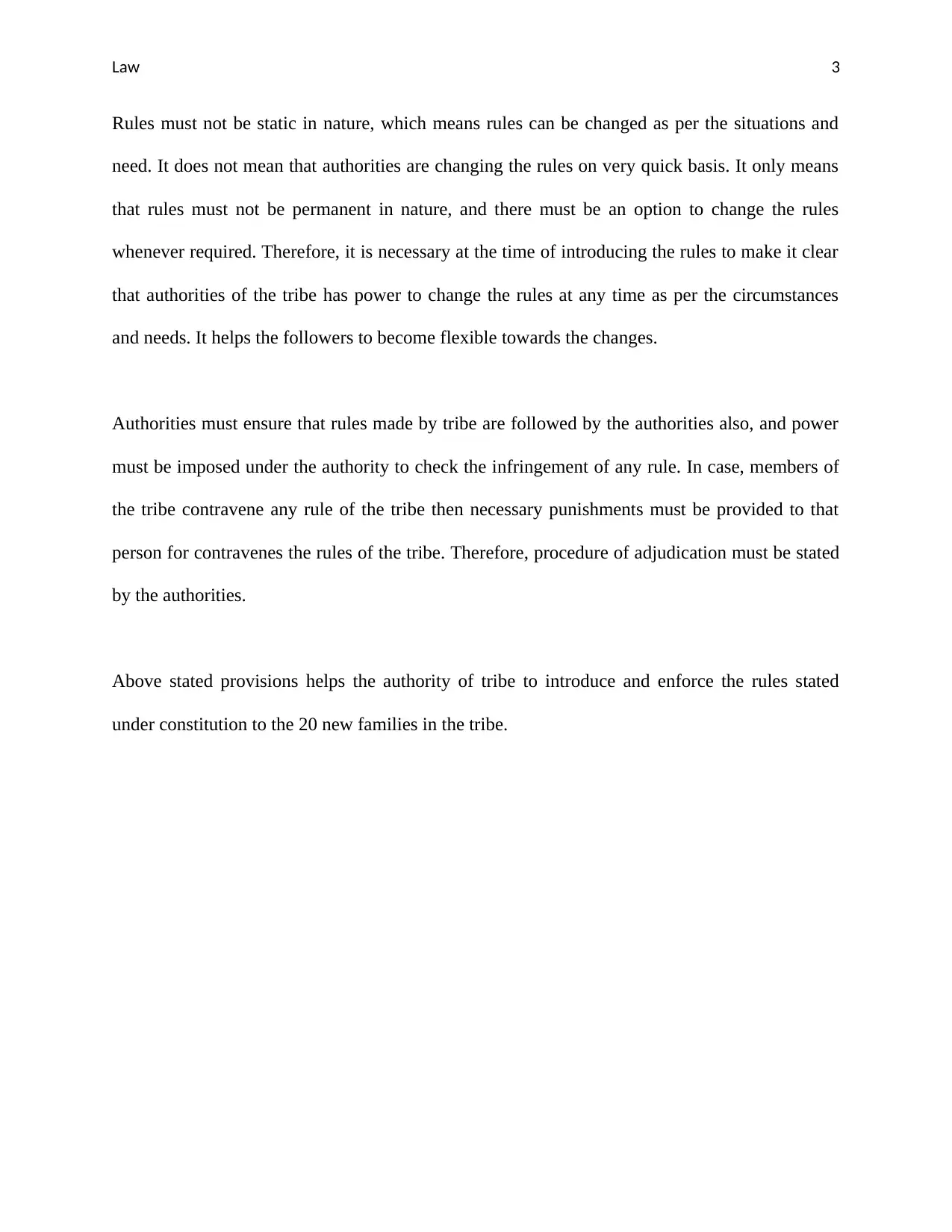
Law 3
Rules must not be static in nature, which means rules can be changed as per the situations and
need. It does not mean that authorities are changing the rules on very quick basis. It only means
that rules must not be permanent in nature, and there must be an option to change the rules
whenever required. Therefore, it is necessary at the time of introducing the rules to make it clear
that authorities of the tribe has power to change the rules at any time as per the circumstances
and needs. It helps the followers to become flexible towards the changes.
Authorities must ensure that rules made by tribe are followed by the authorities also, and power
must be imposed under the authority to check the infringement of any rule. In case, members of
the tribe contravene any rule of the tribe then necessary punishments must be provided to that
person for contravenes the rules of the tribe. Therefore, procedure of adjudication must be stated
by the authorities.
Above stated provisions helps the authority of tribe to introduce and enforce the rules stated
under constitution to the 20 new families in the tribe.
Rules must not be static in nature, which means rules can be changed as per the situations and
need. It does not mean that authorities are changing the rules on very quick basis. It only means
that rules must not be permanent in nature, and there must be an option to change the rules
whenever required. Therefore, it is necessary at the time of introducing the rules to make it clear
that authorities of the tribe has power to change the rules at any time as per the circumstances
and needs. It helps the followers to become flexible towards the changes.
Authorities must ensure that rules made by tribe are followed by the authorities also, and power
must be imposed under the authority to check the infringement of any rule. In case, members of
the tribe contravene any rule of the tribe then necessary punishments must be provided to that
person for contravenes the rules of the tribe. Therefore, procedure of adjudication must be stated
by the authorities.
Above stated provisions helps the authority of tribe to introduce and enforce the rules stated
under constitution to the 20 new families in the tribe.
⊘ This is a preview!⊘
Do you want full access?
Subscribe today to unlock all pages.

Trusted by 1+ million students worldwide
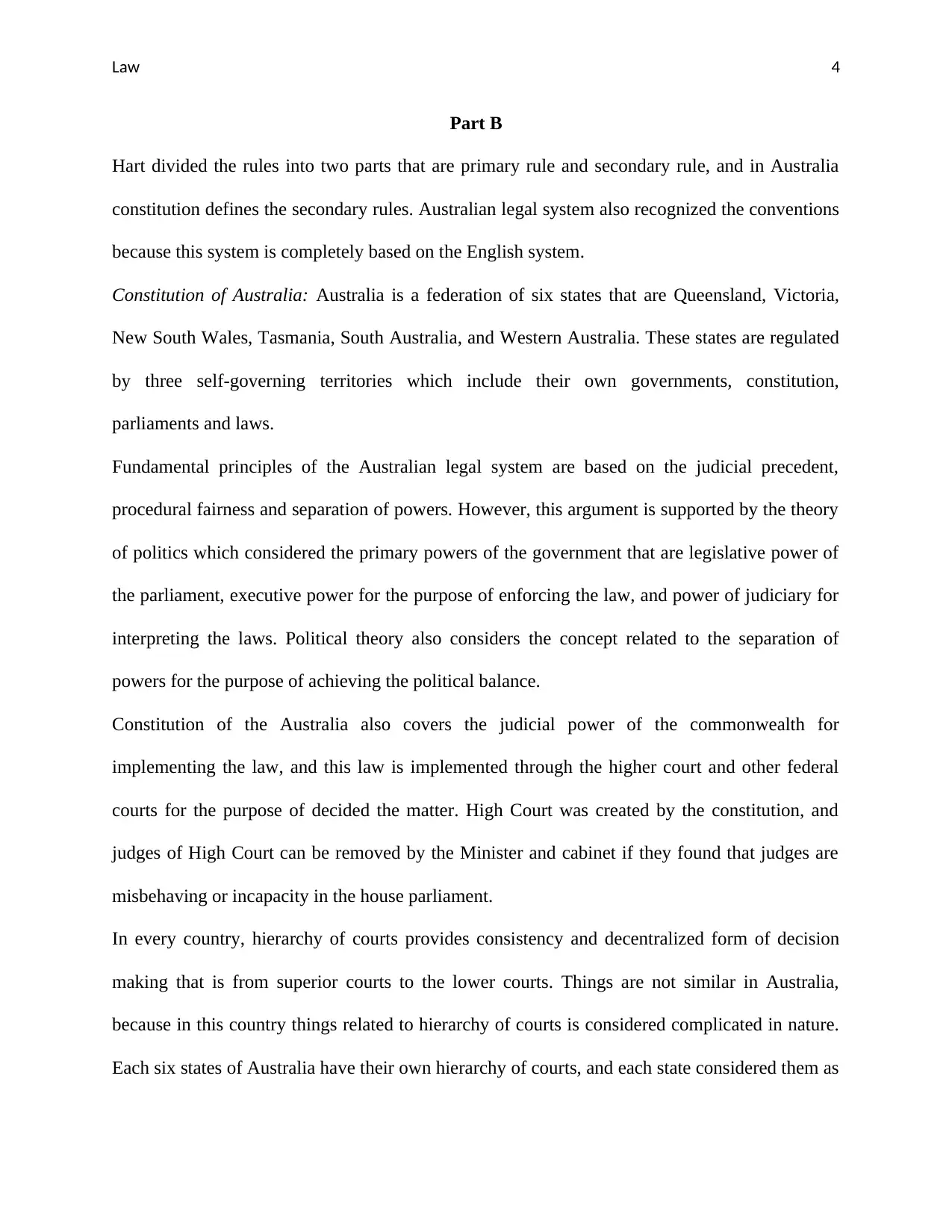
Law 4
Part B
Hart divided the rules into two parts that are primary rule and secondary rule, and in Australia
constitution defines the secondary rules. Australian legal system also recognized the conventions
because this system is completely based on the English system.
Constitution of Australia: Australia is a federation of six states that are Queensland, Victoria,
New South Wales, Tasmania, South Australia, and Western Australia. These states are regulated
by three self-governing territories which include their own governments, constitution,
parliaments and laws.
Fundamental principles of the Australian legal system are based on the judicial precedent,
procedural fairness and separation of powers. However, this argument is supported by the theory
of politics which considered the primary powers of the government that are legislative power of
the parliament, executive power for the purpose of enforcing the law, and power of judiciary for
interpreting the laws. Political theory also considers the concept related to the separation of
powers for the purpose of achieving the political balance.
Constitution of the Australia also covers the judicial power of the commonwealth for
implementing the law, and this law is implemented through the higher court and other federal
courts for the purpose of decided the matter. High Court was created by the constitution, and
judges of High Court can be removed by the Minister and cabinet if they found that judges are
misbehaving or incapacity in the house parliament.
In every country, hierarchy of courts provides consistency and decentralized form of decision
making that is from superior courts to the lower courts. Things are not similar in Australia,
because in this country things related to hierarchy of courts is considered complicated in nature.
Each six states of Australia have their own hierarchy of courts, and each state considered them as
Part B
Hart divided the rules into two parts that are primary rule and secondary rule, and in Australia
constitution defines the secondary rules. Australian legal system also recognized the conventions
because this system is completely based on the English system.
Constitution of Australia: Australia is a federation of six states that are Queensland, Victoria,
New South Wales, Tasmania, South Australia, and Western Australia. These states are regulated
by three self-governing territories which include their own governments, constitution,
parliaments and laws.
Fundamental principles of the Australian legal system are based on the judicial precedent,
procedural fairness and separation of powers. However, this argument is supported by the theory
of politics which considered the primary powers of the government that are legislative power of
the parliament, executive power for the purpose of enforcing the law, and power of judiciary for
interpreting the laws. Political theory also considers the concept related to the separation of
powers for the purpose of achieving the political balance.
Constitution of the Australia also covers the judicial power of the commonwealth for
implementing the law, and this law is implemented through the higher court and other federal
courts for the purpose of decided the matter. High Court was created by the constitution, and
judges of High Court can be removed by the Minister and cabinet if they found that judges are
misbehaving or incapacity in the house parliament.
In every country, hierarchy of courts provides consistency and decentralized form of decision
making that is from superior courts to the lower courts. Things are not similar in Australia,
because in this country things related to hierarchy of courts is considered complicated in nature.
Each six states of Australia have their own hierarchy of courts, and each state considered them as
Paraphrase This Document
Need a fresh take? Get an instant paraphrase of this document with our AI Paraphraser
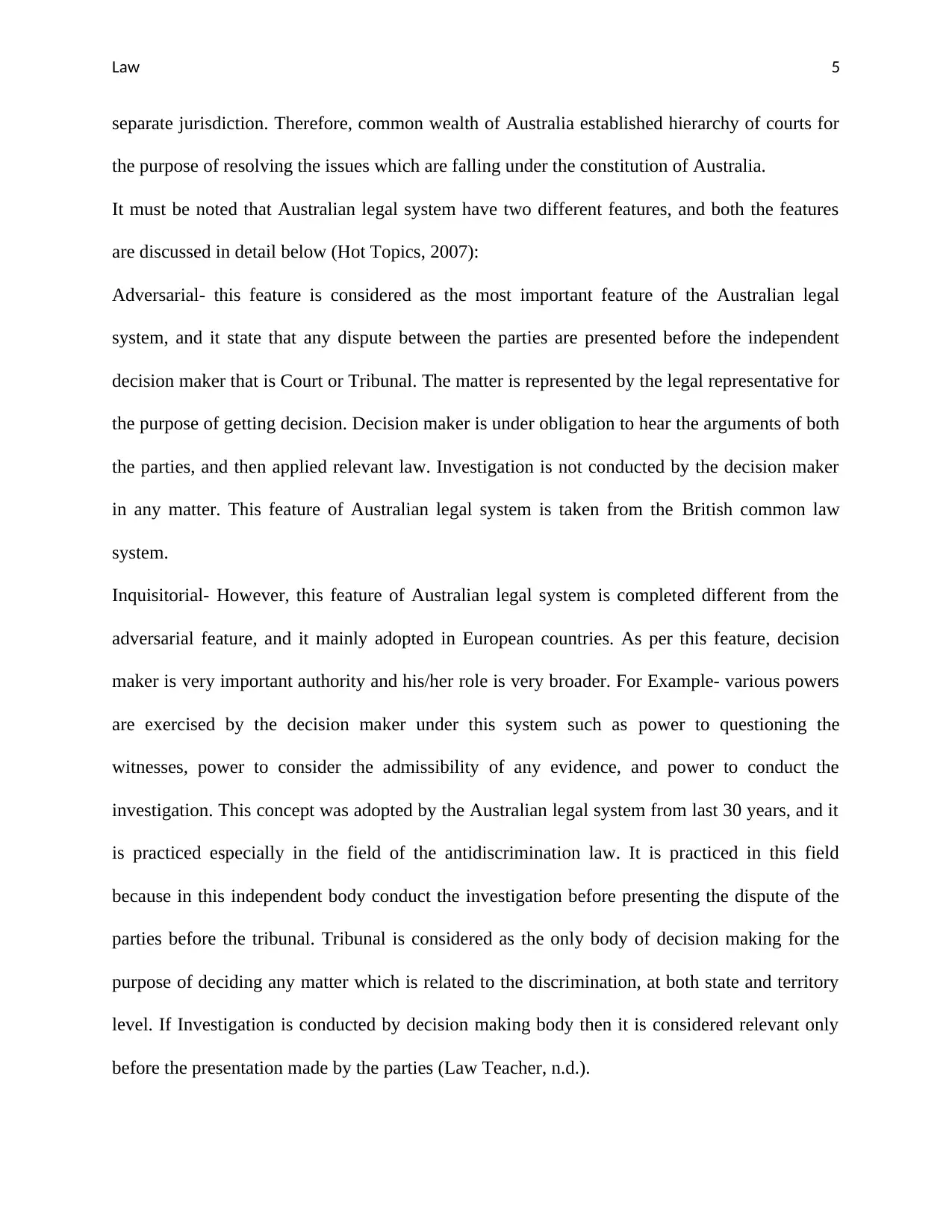
Law 5
separate jurisdiction. Therefore, common wealth of Australia established hierarchy of courts for
the purpose of resolving the issues which are falling under the constitution of Australia.
It must be noted that Australian legal system have two different features, and both the features
are discussed in detail below (Hot Topics, 2007):
Adversarial- this feature is considered as the most important feature of the Australian legal
system, and it state that any dispute between the parties are presented before the independent
decision maker that is Court or Tribunal. The matter is represented by the legal representative for
the purpose of getting decision. Decision maker is under obligation to hear the arguments of both
the parties, and then applied relevant law. Investigation is not conducted by the decision maker
in any matter. This feature of Australian legal system is taken from the British common law
system.
Inquisitorial- However, this feature of Australian legal system is completed different from the
adversarial feature, and it mainly adopted in European countries. As per this feature, decision
maker is very important authority and his/her role is very broader. For Example- various powers
are exercised by the decision maker under this system such as power to questioning the
witnesses, power to consider the admissibility of any evidence, and power to conduct the
investigation. This concept was adopted by the Australian legal system from last 30 years, and it
is practiced especially in the field of the antidiscrimination law. It is practiced in this field
because in this independent body conduct the investigation before presenting the dispute of the
parties before the tribunal. Tribunal is considered as the only body of decision making for the
purpose of deciding any matter which is related to the discrimination, at both state and territory
level. If Investigation is conducted by decision making body then it is considered relevant only
before the presentation made by the parties (Law Teacher, n.d.).
separate jurisdiction. Therefore, common wealth of Australia established hierarchy of courts for
the purpose of resolving the issues which are falling under the constitution of Australia.
It must be noted that Australian legal system have two different features, and both the features
are discussed in detail below (Hot Topics, 2007):
Adversarial- this feature is considered as the most important feature of the Australian legal
system, and it state that any dispute between the parties are presented before the independent
decision maker that is Court or Tribunal. The matter is represented by the legal representative for
the purpose of getting decision. Decision maker is under obligation to hear the arguments of both
the parties, and then applied relevant law. Investigation is not conducted by the decision maker
in any matter. This feature of Australian legal system is taken from the British common law
system.
Inquisitorial- However, this feature of Australian legal system is completed different from the
adversarial feature, and it mainly adopted in European countries. As per this feature, decision
maker is very important authority and his/her role is very broader. For Example- various powers
are exercised by the decision maker under this system such as power to questioning the
witnesses, power to consider the admissibility of any evidence, and power to conduct the
investigation. This concept was adopted by the Australian legal system from last 30 years, and it
is practiced especially in the field of the antidiscrimination law. It is practiced in this field
because in this independent body conduct the investigation before presenting the dispute of the
parties before the tribunal. Tribunal is considered as the only body of decision making for the
purpose of deciding any matter which is related to the discrimination, at both state and territory
level. If Investigation is conducted by decision making body then it is considered relevant only
before the presentation made by the parties (Law Teacher, n.d.).
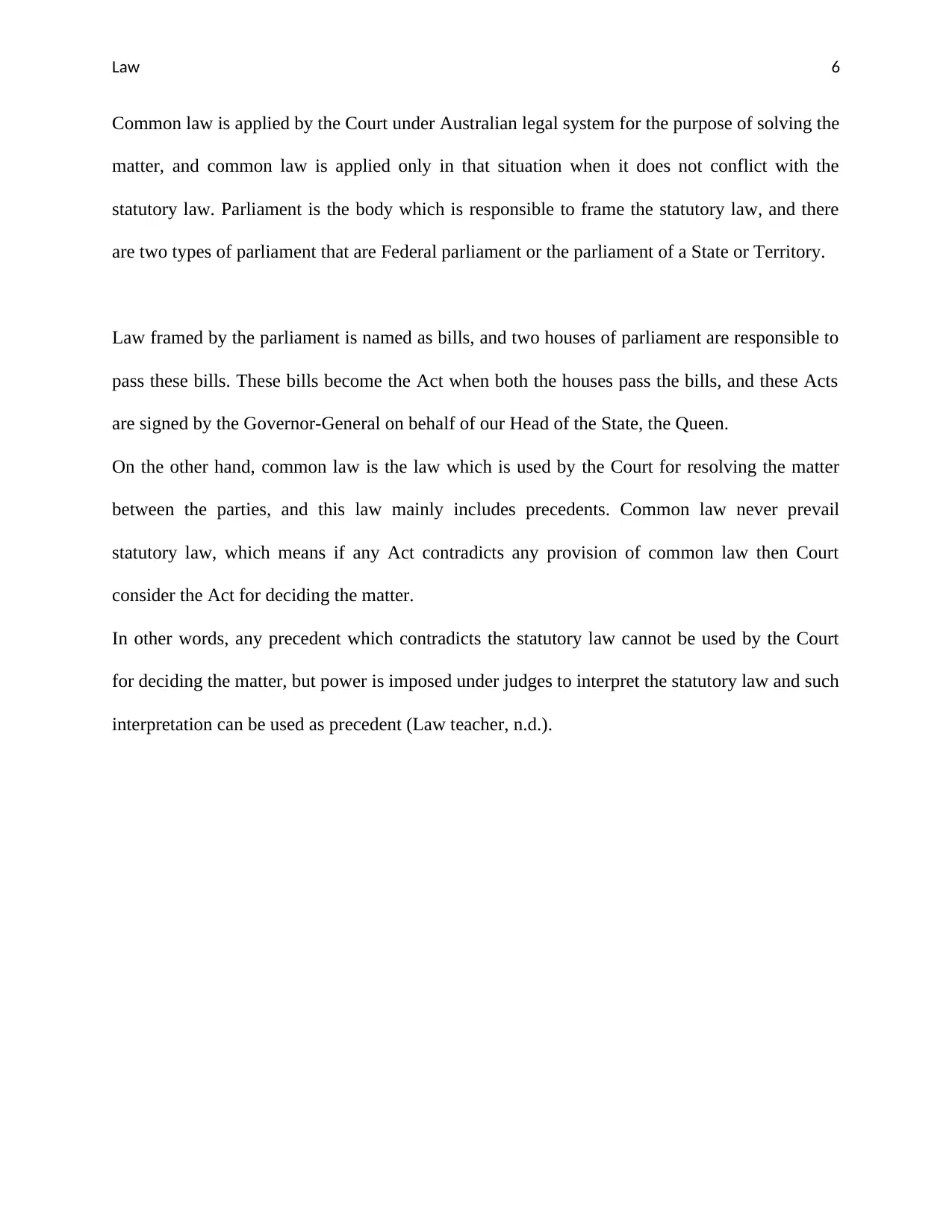
Law 6
Common law is applied by the Court under Australian legal system for the purpose of solving the
matter, and common law is applied only in that situation when it does not conflict with the
statutory law. Parliament is the body which is responsible to frame the statutory law, and there
are two types of parliament that are Federal parliament or the parliament of a State or Territory.
Law framed by the parliament is named as bills, and two houses of parliament are responsible to
pass these bills. These bills become the Act when both the houses pass the bills, and these Acts
are signed by the Governor-General on behalf of our Head of the State, the Queen.
On the other hand, common law is the law which is used by the Court for resolving the matter
between the parties, and this law mainly includes precedents. Common law never prevail
statutory law, which means if any Act contradicts any provision of common law then Court
consider the Act for deciding the matter.
In other words, any precedent which contradicts the statutory law cannot be used by the Court
for deciding the matter, but power is imposed under judges to interpret the statutory law and such
interpretation can be used as precedent (Law teacher, n.d.).
Common law is applied by the Court under Australian legal system for the purpose of solving the
matter, and common law is applied only in that situation when it does not conflict with the
statutory law. Parliament is the body which is responsible to frame the statutory law, and there
are two types of parliament that are Federal parliament or the parliament of a State or Territory.
Law framed by the parliament is named as bills, and two houses of parliament are responsible to
pass these bills. These bills become the Act when both the houses pass the bills, and these Acts
are signed by the Governor-General on behalf of our Head of the State, the Queen.
On the other hand, common law is the law which is used by the Court for resolving the matter
between the parties, and this law mainly includes precedents. Common law never prevail
statutory law, which means if any Act contradicts any provision of common law then Court
consider the Act for deciding the matter.
In other words, any precedent which contradicts the statutory law cannot be used by the Court
for deciding the matter, but power is imposed under judges to interpret the statutory law and such
interpretation can be used as precedent (Law teacher, n.d.).
⊘ This is a preview!⊘
Do you want full access?
Subscribe today to unlock all pages.

Trusted by 1+ million students worldwide
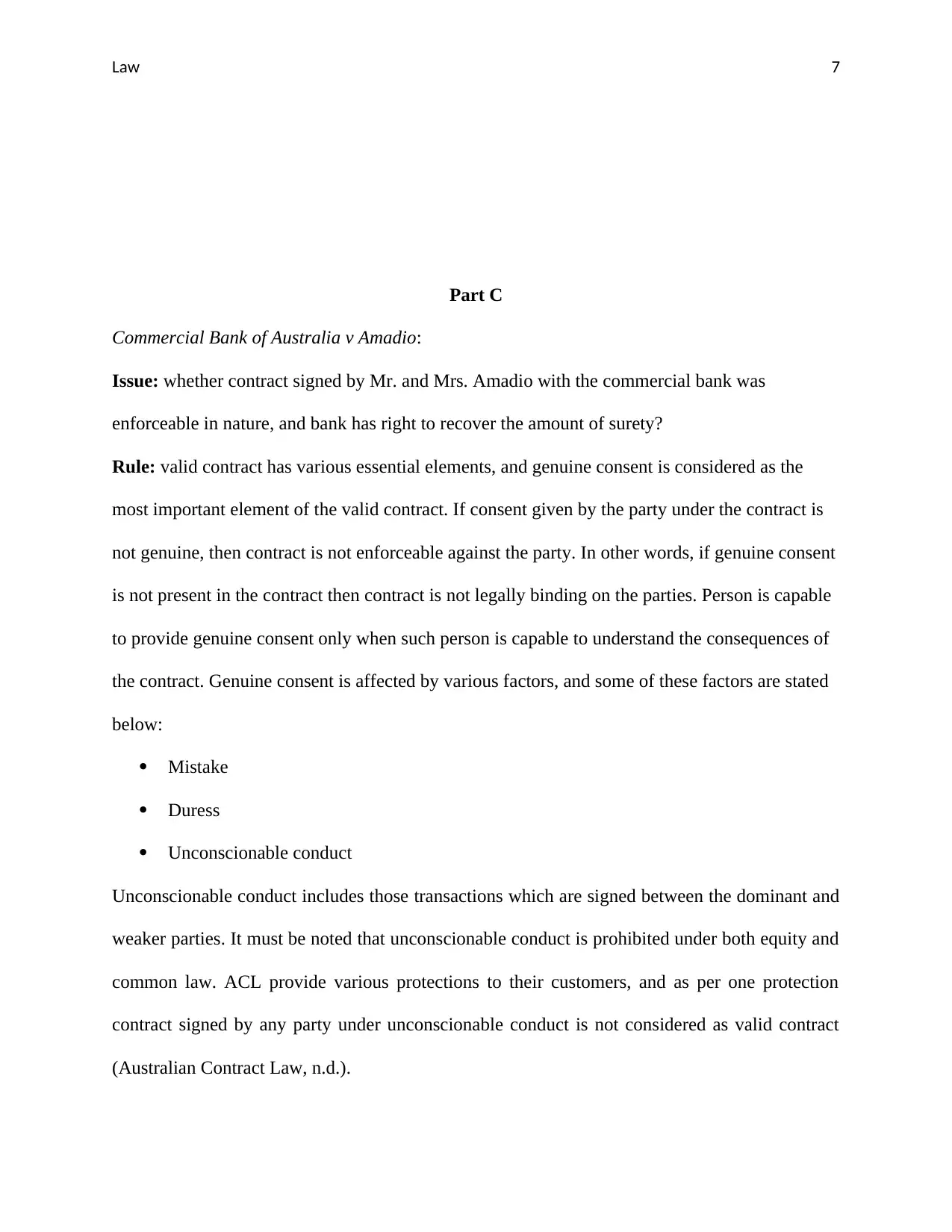
Law 7
Part C
Commercial Bank of Australia v Amadio:
Issue: whether contract signed by Mr. and Mrs. Amadio with the commercial bank was
enforceable in nature, and bank has right to recover the amount of surety?
Rule: valid contract has various essential elements, and genuine consent is considered as the
most important element of the valid contract. If consent given by the party under the contract is
not genuine, then contract is not enforceable against the party. In other words, if genuine consent
is not present in the contract then contract is not legally binding on the parties. Person is capable
to provide genuine consent only when such person is capable to understand the consequences of
the contract. Genuine consent is affected by various factors, and some of these factors are stated
below:
Mistake
Duress
Unconscionable conduct
Unconscionable conduct includes those transactions which are signed between the dominant and
weaker parties. It must be noted that unconscionable conduct is prohibited under both equity and
common law. ACL provide various protections to their customers, and as per one protection
contract signed by any party under unconscionable conduct is not considered as valid contract
(Australian Contract Law, n.d.).
Part C
Commercial Bank of Australia v Amadio:
Issue: whether contract signed by Mr. and Mrs. Amadio with the commercial bank was
enforceable in nature, and bank has right to recover the amount of surety?
Rule: valid contract has various essential elements, and genuine consent is considered as the
most important element of the valid contract. If consent given by the party under the contract is
not genuine, then contract is not enforceable against the party. In other words, if genuine consent
is not present in the contract then contract is not legally binding on the parties. Person is capable
to provide genuine consent only when such person is capable to understand the consequences of
the contract. Genuine consent is affected by various factors, and some of these factors are stated
below:
Mistake
Duress
Unconscionable conduct
Unconscionable conduct includes those transactions which are signed between the dominant and
weaker parties. It must be noted that unconscionable conduct is prohibited under both equity and
common law. ACL provide various protections to their customers, and as per one protection
contract signed by any party under unconscionable conduct is not considered as valid contract
(Australian Contract Law, n.d.).
Paraphrase This Document
Need a fresh take? Get an instant paraphrase of this document with our AI Paraphraser
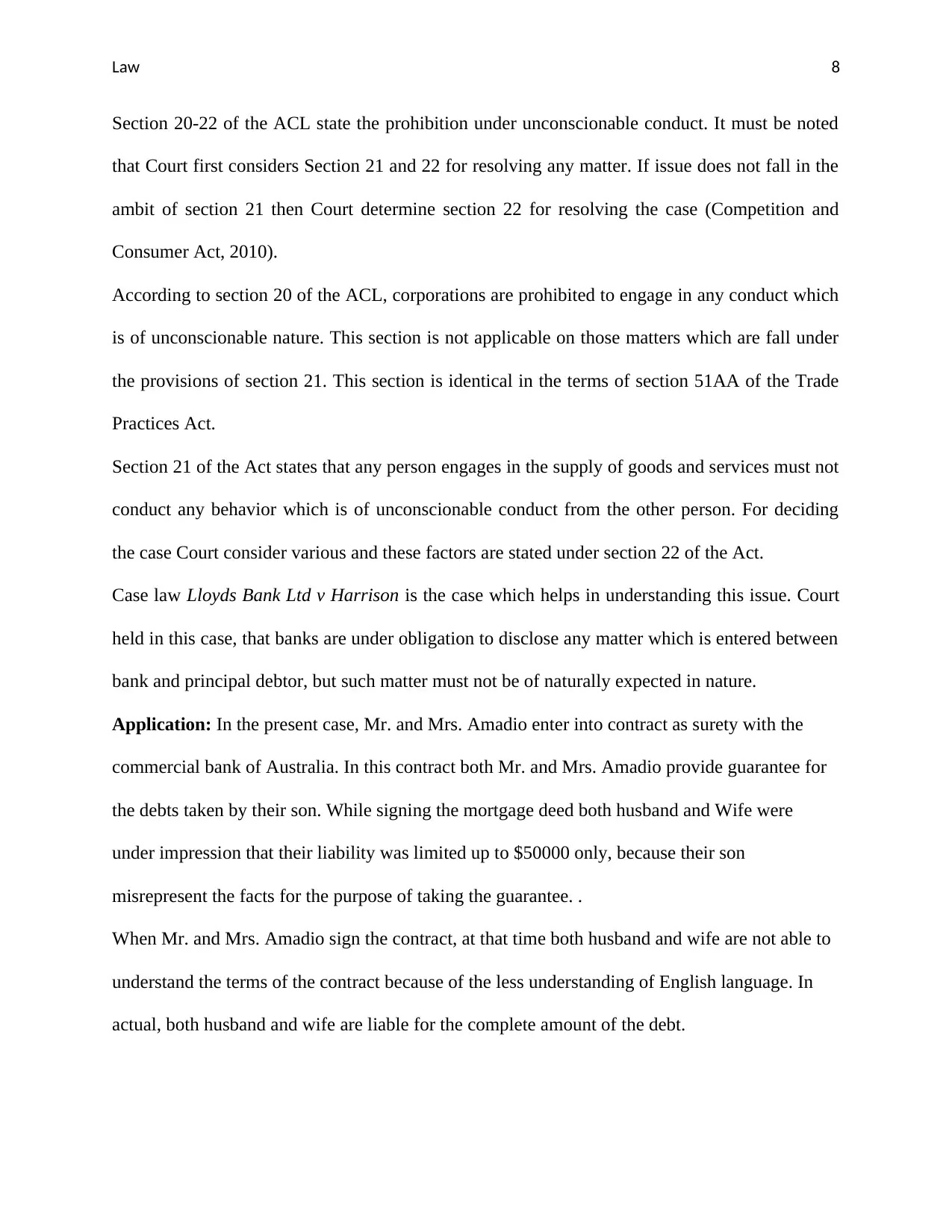
Law 8
Section 20-22 of the ACL state the prohibition under unconscionable conduct. It must be noted
that Court first considers Section 21 and 22 for resolving any matter. If issue does not fall in the
ambit of section 21 then Court determine section 22 for resolving the case (Competition and
Consumer Act, 2010).
According to section 20 of the ACL, corporations are prohibited to engage in any conduct which
is of unconscionable nature. This section is not applicable on those matters which are fall under
the provisions of section 21. This section is identical in the terms of section 51AA of the Trade
Practices Act.
Section 21 of the Act states that any person engages in the supply of goods and services must not
conduct any behavior which is of unconscionable conduct from the other person. For deciding
the case Court consider various and these factors are stated under section 22 of the Act.
Case law Lloyds Bank Ltd v Harrison is the case which helps in understanding this issue. Court
held in this case, that banks are under obligation to disclose any matter which is entered between
bank and principal debtor, but such matter must not be of naturally expected in nature.
Application: In the present case, Mr. and Mrs. Amadio enter into contract as surety with the
commercial bank of Australia. In this contract both Mr. and Mrs. Amadio provide guarantee for
the debts taken by their son. While signing the mortgage deed both husband and Wife were
under impression that their liability was limited up to $50000 only, because their son
misrepresent the facts for the purpose of taking the guarantee. .
When Mr. and Mrs. Amadio sign the contract, at that time both husband and wife are not able to
understand the terms of the contract because of the less understanding of English language. In
actual, both husband and wife are liable for the complete amount of the debt.
Section 20-22 of the ACL state the prohibition under unconscionable conduct. It must be noted
that Court first considers Section 21 and 22 for resolving any matter. If issue does not fall in the
ambit of section 21 then Court determine section 22 for resolving the case (Competition and
Consumer Act, 2010).
According to section 20 of the ACL, corporations are prohibited to engage in any conduct which
is of unconscionable nature. This section is not applicable on those matters which are fall under
the provisions of section 21. This section is identical in the terms of section 51AA of the Trade
Practices Act.
Section 21 of the Act states that any person engages in the supply of goods and services must not
conduct any behavior which is of unconscionable conduct from the other person. For deciding
the case Court consider various and these factors are stated under section 22 of the Act.
Case law Lloyds Bank Ltd v Harrison is the case which helps in understanding this issue. Court
held in this case, that banks are under obligation to disclose any matter which is entered between
bank and principal debtor, but such matter must not be of naturally expected in nature.
Application: In the present case, Mr. and Mrs. Amadio enter into contract as surety with the
commercial bank of Australia. In this contract both Mr. and Mrs. Amadio provide guarantee for
the debts taken by their son. While signing the mortgage deed both husband and Wife were
under impression that their liability was limited up to $50000 only, because their son
misrepresent the facts for the purpose of taking the guarantee. .
When Mr. and Mrs. Amadio sign the contract, at that time both husband and wife are not able to
understand the terms of the contract because of the less understanding of English language. In
actual, both husband and wife are liable for the complete amount of the debt.
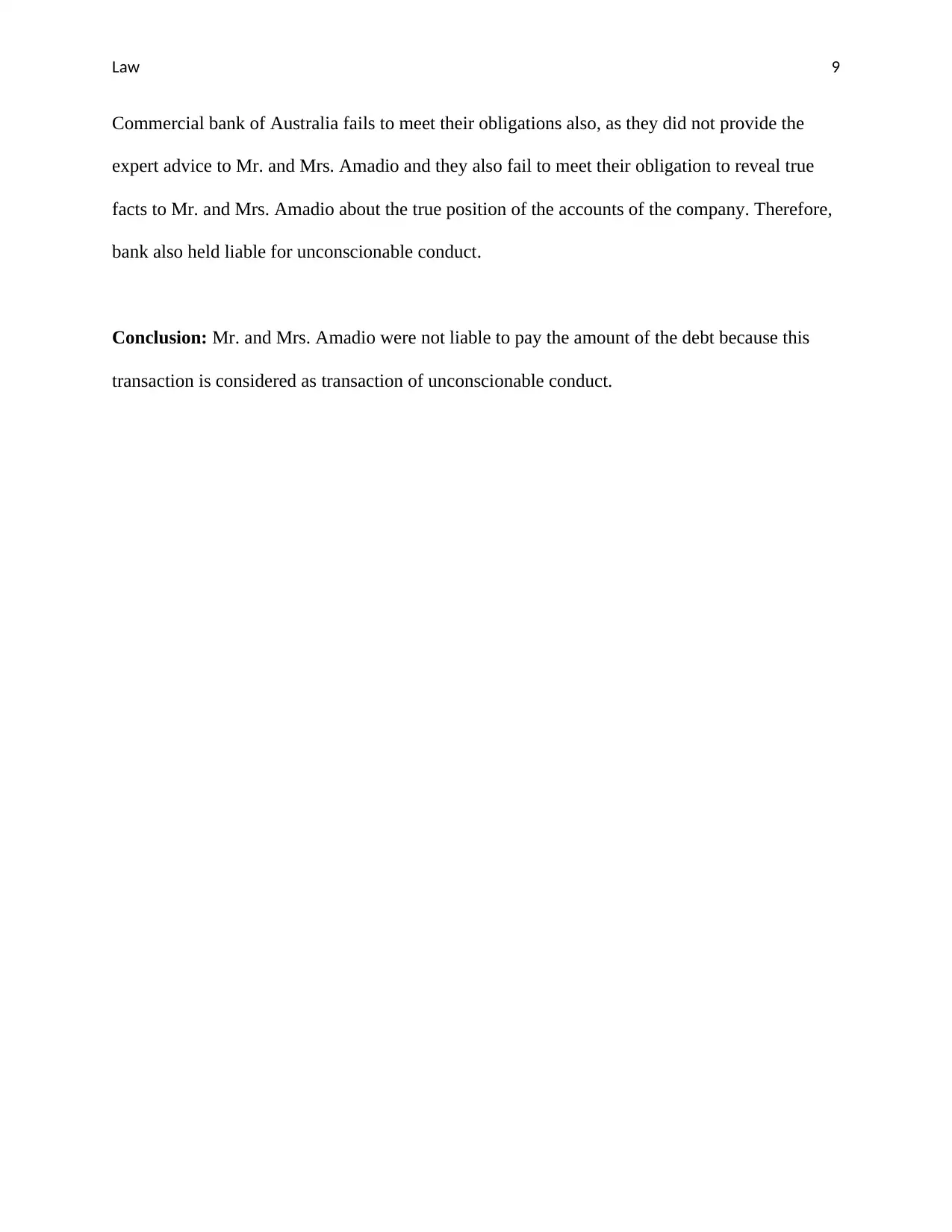
Law 9
Commercial bank of Australia fails to meet their obligations also, as they did not provide the
expert advice to Mr. and Mrs. Amadio and they also fail to meet their obligation to reveal true
facts to Mr. and Mrs. Amadio about the true position of the accounts of the company. Therefore,
bank also held liable for unconscionable conduct.
Conclusion: Mr. and Mrs. Amadio were not liable to pay the amount of the debt because this
transaction is considered as transaction of unconscionable conduct.
Commercial bank of Australia fails to meet their obligations also, as they did not provide the
expert advice to Mr. and Mrs. Amadio and they also fail to meet their obligation to reveal true
facts to Mr. and Mrs. Amadio about the true position of the accounts of the company. Therefore,
bank also held liable for unconscionable conduct.
Conclusion: Mr. and Mrs. Amadio were not liable to pay the amount of the debt because this
transaction is considered as transaction of unconscionable conduct.
⊘ This is a preview!⊘
Do you want full access?
Subscribe today to unlock all pages.

Trusted by 1+ million students worldwide
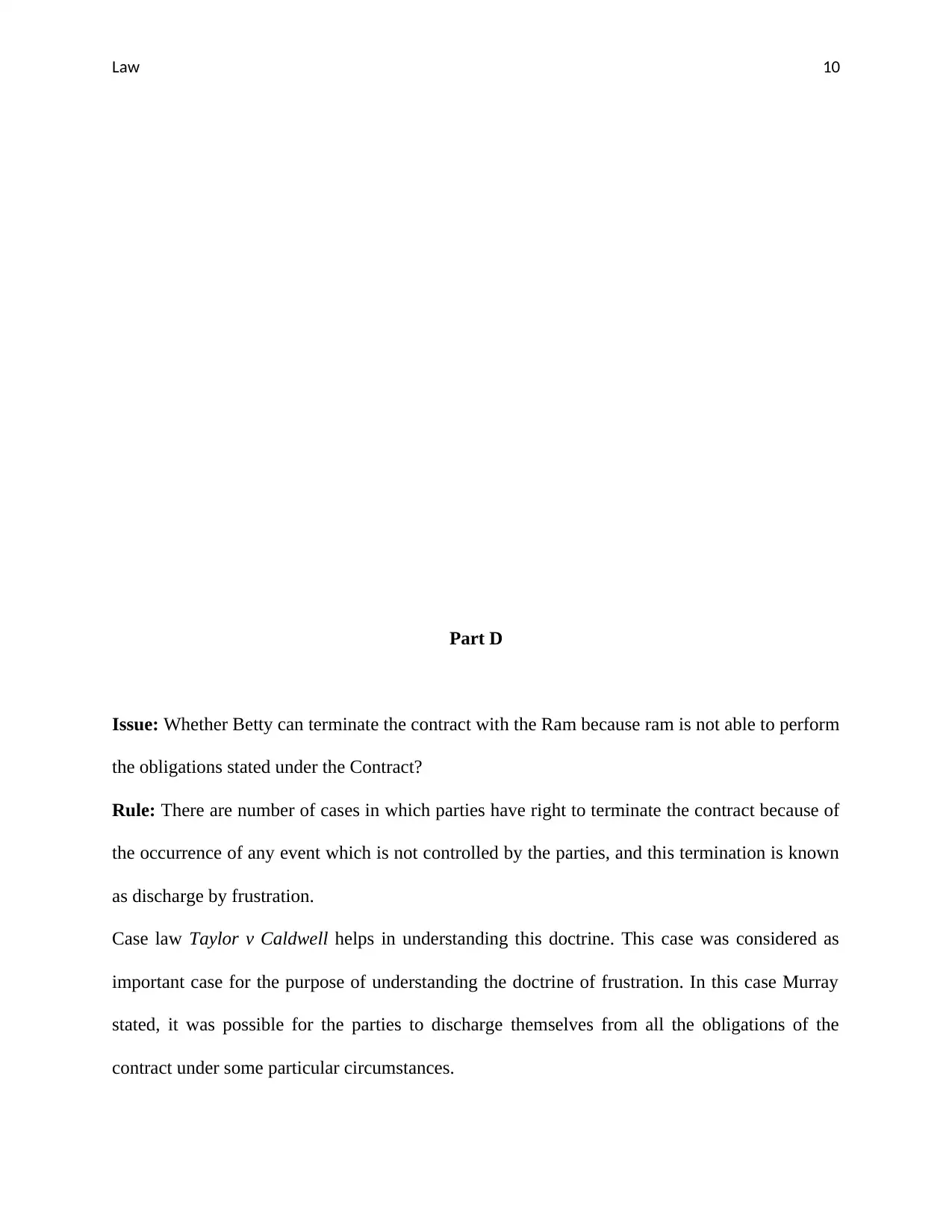
Law 10
Part D
Issue: Whether Betty can terminate the contract with the Ram because ram is not able to perform
the obligations stated under the Contract?
Rule: There are number of cases in which parties have right to terminate the contract because of
the occurrence of any event which is not controlled by the parties, and this termination is known
as discharge by frustration.
Case law Taylor v Caldwell helps in understanding this doctrine. This case was considered as
important case for the purpose of understanding the doctrine of frustration. In this case Murray
stated, it was possible for the parties to discharge themselves from all the obligations of the
contract under some particular circumstances.
Part D
Issue: Whether Betty can terminate the contract with the Ram because ram is not able to perform
the obligations stated under the Contract?
Rule: There are number of cases in which parties have right to terminate the contract because of
the occurrence of any event which is not controlled by the parties, and this termination is known
as discharge by frustration.
Case law Taylor v Caldwell helps in understanding this doctrine. This case was considered as
important case for the purpose of understanding the doctrine of frustration. In this case Murray
stated, it was possible for the parties to discharge themselves from all the obligations of the
contract under some particular circumstances.
Paraphrase This Document
Need a fresh take? Get an instant paraphrase of this document with our AI Paraphraser
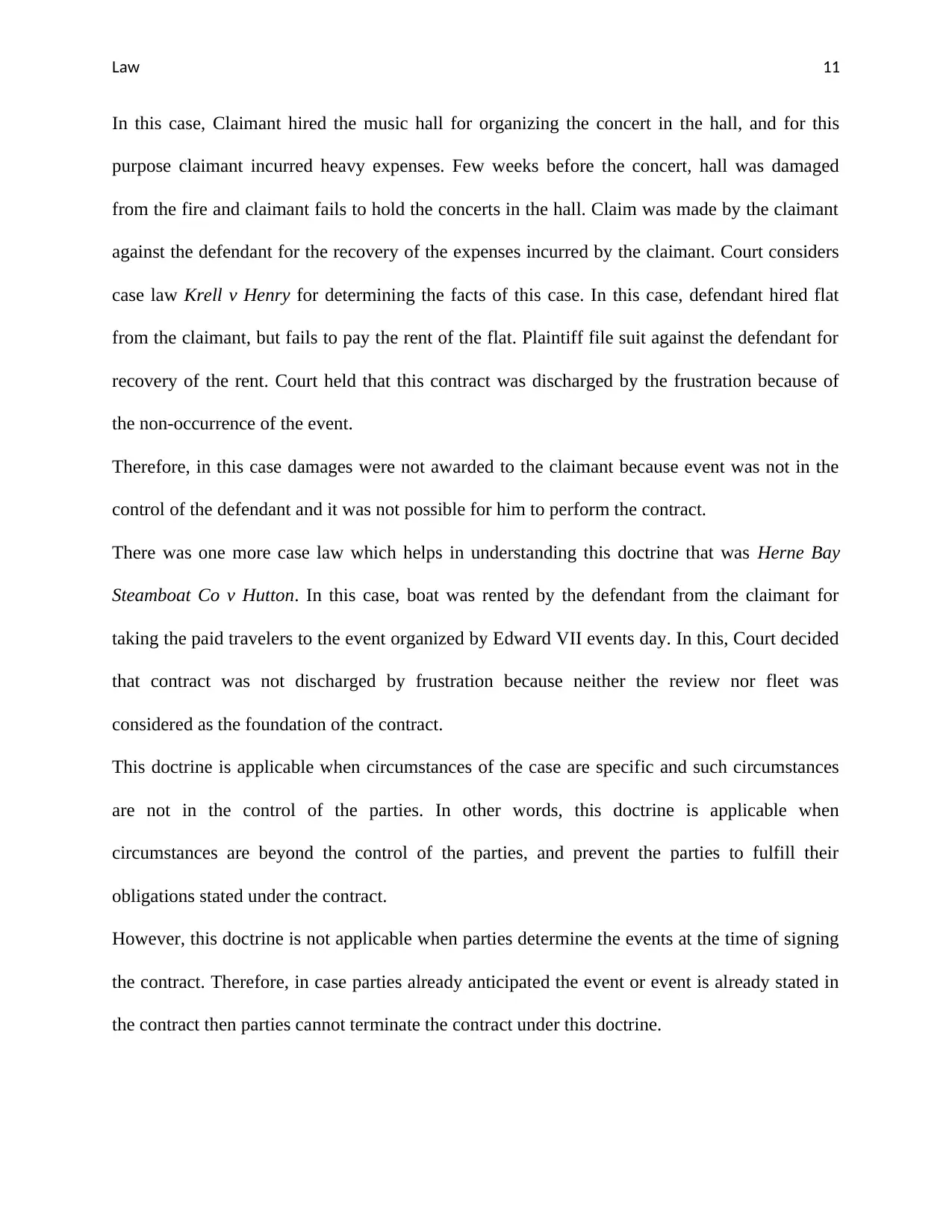
Law 11
In this case, Claimant hired the music hall for organizing the concert in the hall, and for this
purpose claimant incurred heavy expenses. Few weeks before the concert, hall was damaged
from the fire and claimant fails to hold the concerts in the hall. Claim was made by the claimant
against the defendant for the recovery of the expenses incurred by the claimant. Court considers
case law Krell v Henry for determining the facts of this case. In this case, defendant hired flat
from the claimant, but fails to pay the rent of the flat. Plaintiff file suit against the defendant for
recovery of the rent. Court held that this contract was discharged by the frustration because of
the non-occurrence of the event.
Therefore, in this case damages were not awarded to the claimant because event was not in the
control of the defendant and it was not possible for him to perform the contract.
There was one more case law which helps in understanding this doctrine that was Herne Bay
Steamboat Co v Hutton. In this case, boat was rented by the defendant from the claimant for
taking the paid travelers to the event organized by Edward VII events day. In this, Court decided
that contract was not discharged by frustration because neither the review nor fleet was
considered as the foundation of the contract.
This doctrine is applicable when circumstances of the case are specific and such circumstances
are not in the control of the parties. In other words, this doctrine is applicable when
circumstances are beyond the control of the parties, and prevent the parties to fulfill their
obligations stated under the contract.
However, this doctrine is not applicable when parties determine the events at the time of signing
the contract. Therefore, in case parties already anticipated the event or event is already stated in
the contract then parties cannot terminate the contract under this doctrine.
In this case, Claimant hired the music hall for organizing the concert in the hall, and for this
purpose claimant incurred heavy expenses. Few weeks before the concert, hall was damaged
from the fire and claimant fails to hold the concerts in the hall. Claim was made by the claimant
against the defendant for the recovery of the expenses incurred by the claimant. Court considers
case law Krell v Henry for determining the facts of this case. In this case, defendant hired flat
from the claimant, but fails to pay the rent of the flat. Plaintiff file suit against the defendant for
recovery of the rent. Court held that this contract was discharged by the frustration because of
the non-occurrence of the event.
Therefore, in this case damages were not awarded to the claimant because event was not in the
control of the defendant and it was not possible for him to perform the contract.
There was one more case law which helps in understanding this doctrine that was Herne Bay
Steamboat Co v Hutton. In this case, boat was rented by the defendant from the claimant for
taking the paid travelers to the event organized by Edward VII events day. In this, Court decided
that contract was not discharged by frustration because neither the review nor fleet was
considered as the foundation of the contract.
This doctrine is applicable when circumstances of the case are specific and such circumstances
are not in the control of the parties. In other words, this doctrine is applicable when
circumstances are beyond the control of the parties, and prevent the parties to fulfill their
obligations stated under the contract.
However, this doctrine is not applicable when parties determine the events at the time of signing
the contract. Therefore, in case parties already anticipated the event or event is already stated in
the contract then parties cannot terminate the contract under this doctrine.
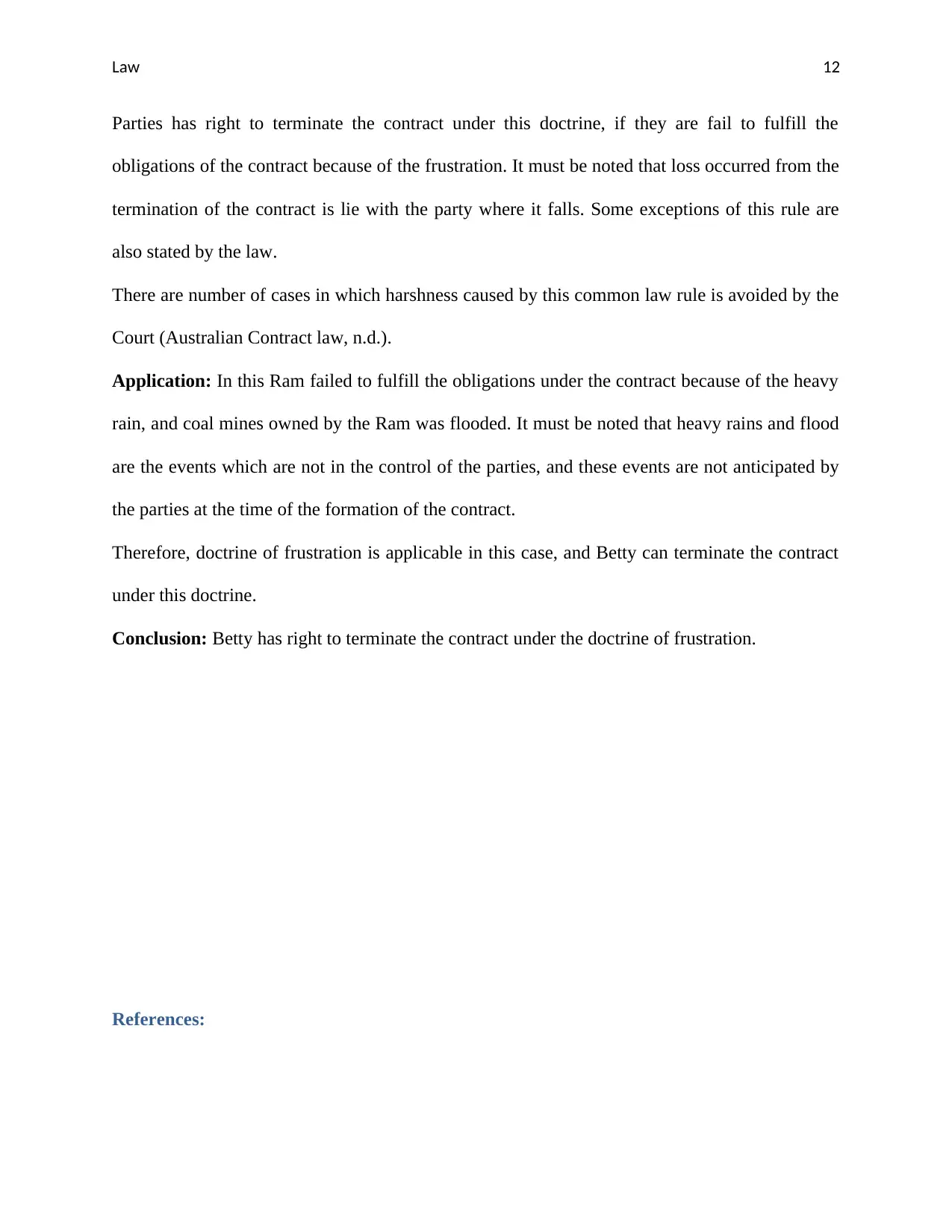
Law 12
Parties has right to terminate the contract under this doctrine, if they are fail to fulfill the
obligations of the contract because of the frustration. It must be noted that loss occurred from the
termination of the contract is lie with the party where it falls. Some exceptions of this rule are
also stated by the law.
There are number of cases in which harshness caused by this common law rule is avoided by the
Court (Australian Contract law, n.d.).
Application: In this Ram failed to fulfill the obligations under the contract because of the heavy
rain, and coal mines owned by the Ram was flooded. It must be noted that heavy rains and flood
are the events which are not in the control of the parties, and these events are not anticipated by
the parties at the time of the formation of the contract.
Therefore, doctrine of frustration is applicable in this case, and Betty can terminate the contract
under this doctrine.
Conclusion: Betty has right to terminate the contract under the doctrine of frustration.
References:
Parties has right to terminate the contract under this doctrine, if they are fail to fulfill the
obligations of the contract because of the frustration. It must be noted that loss occurred from the
termination of the contract is lie with the party where it falls. Some exceptions of this rule are
also stated by the law.
There are number of cases in which harshness caused by this common law rule is avoided by the
Court (Australian Contract law, n.d.).
Application: In this Ram failed to fulfill the obligations under the contract because of the heavy
rain, and coal mines owned by the Ram was flooded. It must be noted that heavy rains and flood
are the events which are not in the control of the parties, and these events are not anticipated by
the parties at the time of the formation of the contract.
Therefore, doctrine of frustration is applicable in this case, and Betty can terminate the contract
under this doctrine.
Conclusion: Betty has right to terminate the contract under the doctrine of frustration.
References:
⊘ This is a preview!⊘
Do you want full access?
Subscribe today to unlock all pages.

Trusted by 1+ million students worldwide
1 out of 13
Related Documents
Your All-in-One AI-Powered Toolkit for Academic Success.
+13062052269
info@desklib.com
Available 24*7 on WhatsApp / Email
![[object Object]](/_next/static/media/star-bottom.7253800d.svg)
Unlock your academic potential
Copyright © 2020–2025 A2Z Services. All Rights Reserved. Developed and managed by ZUCOL.





